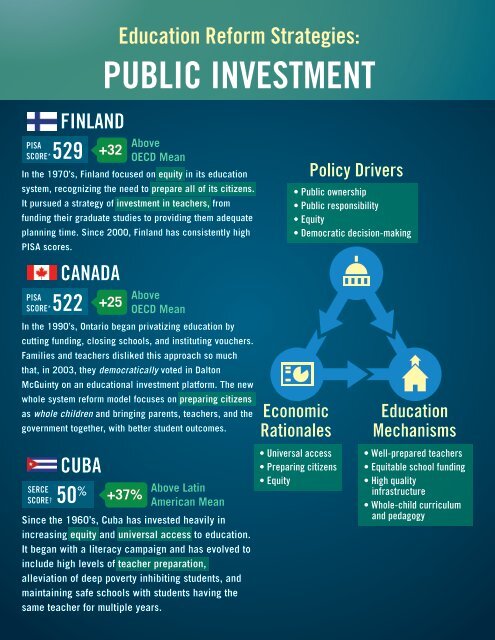FINLAND SWEDEN
2iNsQp9
2iNsQp9
Create successful ePaper yourself
Turn your PDF publications into a flip-book with our unique Google optimized e-Paper software.
PISA<br />
SCORE*<br />
PISA<br />
SCORE*<br />
SERCE<br />
SCORE†<br />
<strong>FINLAND</strong><br />
529<br />
CANADA<br />
522<br />
CUBA<br />
50 %<br />
Education Reform Strategies:<br />
PUBLIC INVESTMENT<br />
+32<br />
+25<br />
+37%<br />
Above<br />
OECD Mean<br />
In the 1970’s, Finland focused on equity in its education<br />
system, recognizing the need to prepare all of its citizens.<br />
It pursued a strategy of investment in teachers, from<br />
funding their graduate studies to providing them adequate<br />
planning time. Since 2000, Finland has consistently high<br />
PISA scores.<br />
Above<br />
OECD Mean<br />
In the 1990’s, Ontario began privatizing education by<br />
cutting funding, closing schools, and instituting vouchers.<br />
Families and teachers disliked this approach so much<br />
that, in 2003, they democratically voted in Dalton<br />
McGuinty on an educational investment platform. The new<br />
whole system reform model focuses on preparing citizens<br />
as whole children and bringing parents, teachers, and the<br />
government together, with better student outcomes.<br />
Above Latin<br />
American Mean<br />
Since the 1960’s, Cuba has invested heavily in<br />
increasing equity and universal access to education.<br />
It began with a literacy campaign and has evolved to<br />
include high levels of teacher preparation,<br />
alleviation of deep poverty inhibiting students, and<br />
maintaining safe schools with students having the<br />
same teacher for multiple years.<br />
Economic<br />
Rationales<br />
Policy Drivers<br />
• Public ownership<br />
• Public responsibility<br />
• Equity<br />
• Democratic decision-making<br />
• Universal access<br />
• Preparing citizens<br />
• Equity<br />
Education<br />
Mechanisms<br />
• Well-prepared teachers<br />
• Equitable school funding<br />
• High quality<br />
infrastructure<br />
• Whole-child curriculum<br />
and pedagogy


